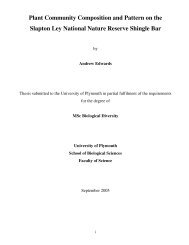Population distribution and conservation status of notable ...
Population distribution and conservation status of notable ...
Population distribution and conservation status of notable ...
You also want an ePaper? Increase the reach of your titles
YUMPU automatically turns print PDFs into web optimized ePapers that Google loves.
SURVEY<br />
Despite their scarcity there has been no recent survey to establish <strong>status</strong> <strong>and</strong><br />
population size <strong>of</strong> S. rupicola <strong>and</strong> S. porrigentiformis within Torbay. Given the<br />
uncertainty <strong>of</strong> these population sizes <strong>and</strong> the potential effects <strong>of</strong> planned site<br />
management, it is important that a monitoring programme is established to<br />
ensure maintenance <strong>of</strong> these populations. No seedlings were recorded or<br />
observed by Bradshaw in 1984/5 <strong>and</strong> there is concern that the populations are<br />
not successfully recruiting. Historic Ordnance Survey maps <strong>and</strong> photographs <strong>of</strong><br />
the two predominantly wooded sites, Babbacombe <strong>and</strong> Churston, from late<br />
1800’s to the 1930’s, show them to have been open grassl<strong>and</strong> with scrub with<br />
occasional small trees scattered across the slopes.<br />
Sites<br />
The areas surveyed were<br />
1. Babbacombe slopes SSSI – an area between Babbacombe downs <strong>and</strong><br />
the coast. (Fig. 3). NGR SX 926 656<br />
2. Redgate Cliffs SSSI – from Redgate beach up the cliff face between<br />
Ansteys cove <strong>and</strong> Walls Hill. (Fig. 4). NGR SX 934 647<br />
3. Churston Cove CWS – an area stretching from fishcombe point across to<br />
the battery gardens. (Fig.5). NGR SX 917 570<br />
Note: Wall’s Hill was surveyed in 2010, see Appendices photographs pg 20.<br />
The 2008 survey repeated that <strong>of</strong> Margaret Bradshaw in 1984-5 in order to detect<br />
any changes in population size during the last 23 years. All records have been<br />
lodged with the county recorder for vascular plants, R.E. N. Smith.<br />
All trees had their location recorded with a 10 figure GPS (Global Positioning<br />
System) coordinate with the accuracy <strong>of</strong> the GPS unit noted. The locations <strong>of</strong> the<br />
trees were also described <strong>and</strong> mapped on large scale site maps. (Figures 3-5).<br />
The larger trees were tagged using aluminium tree tags which carry a unique<br />
identifying number <strong>and</strong> the canopy density was measured.<br />
Using tree ring data from stems found already broken it was possible to estimate<br />
the stem ages <strong>of</strong> other trees <strong>and</strong> thus calculate recruitment since 1985.<br />
DISTRIBUTION ACROSS THE SITES<br />
Between them, the three study sites support or have supported 100% <strong>of</strong> all S.<br />
rupicola ever recorded in Torbay <strong>and</strong> 80 – 90% <strong>of</strong> S. porrigentiformis.<br />
Habitats present<br />
All the sites have steep coastal slopes, cliffs <strong>and</strong> quarried areas. Babbacombe<br />
<strong>and</strong> Redgate have areas <strong>of</strong> loose rock. Babbacombe is dominated by high<br />
canopy Ash Fraxinus excelsior <strong>and</strong> Sycamore Acer pseudoplatanus <strong>and</strong> there is<br />
little open habitat. Churston also has large areas <strong>of</strong> similar woodl<strong>and</strong> but also<br />
9




